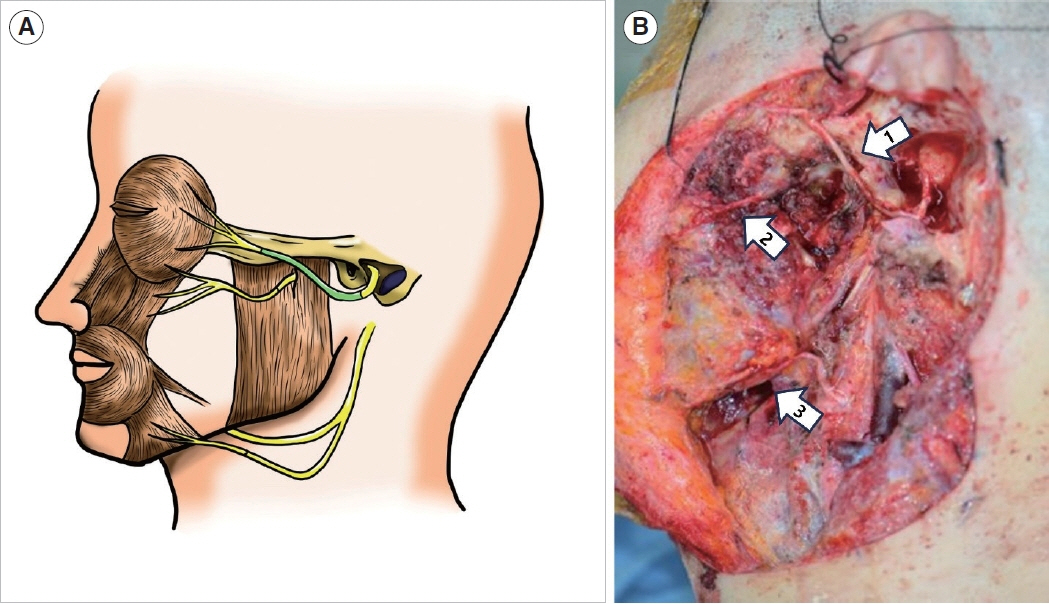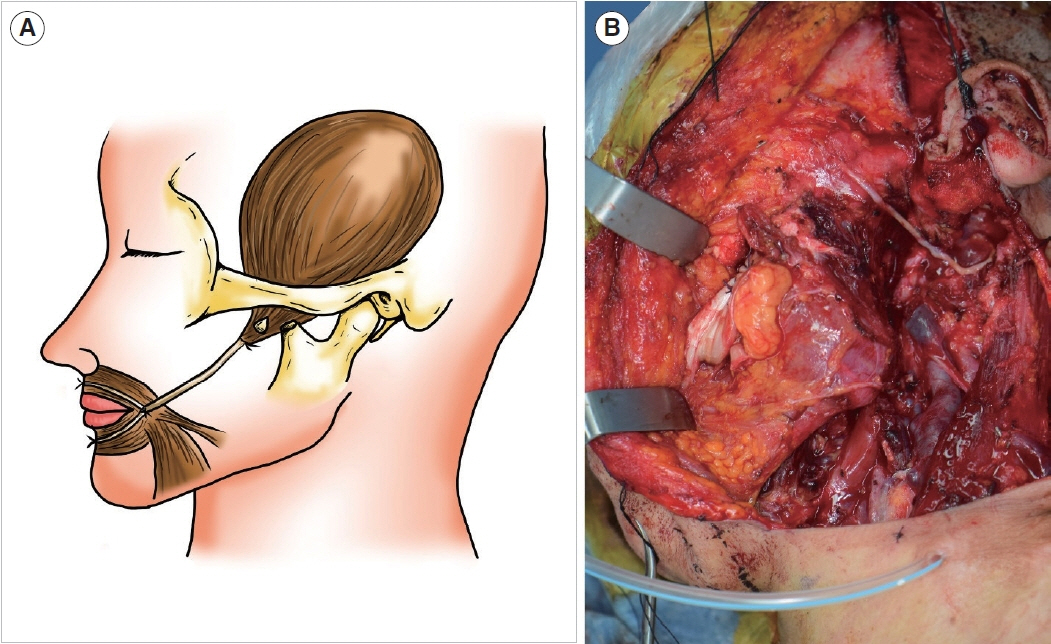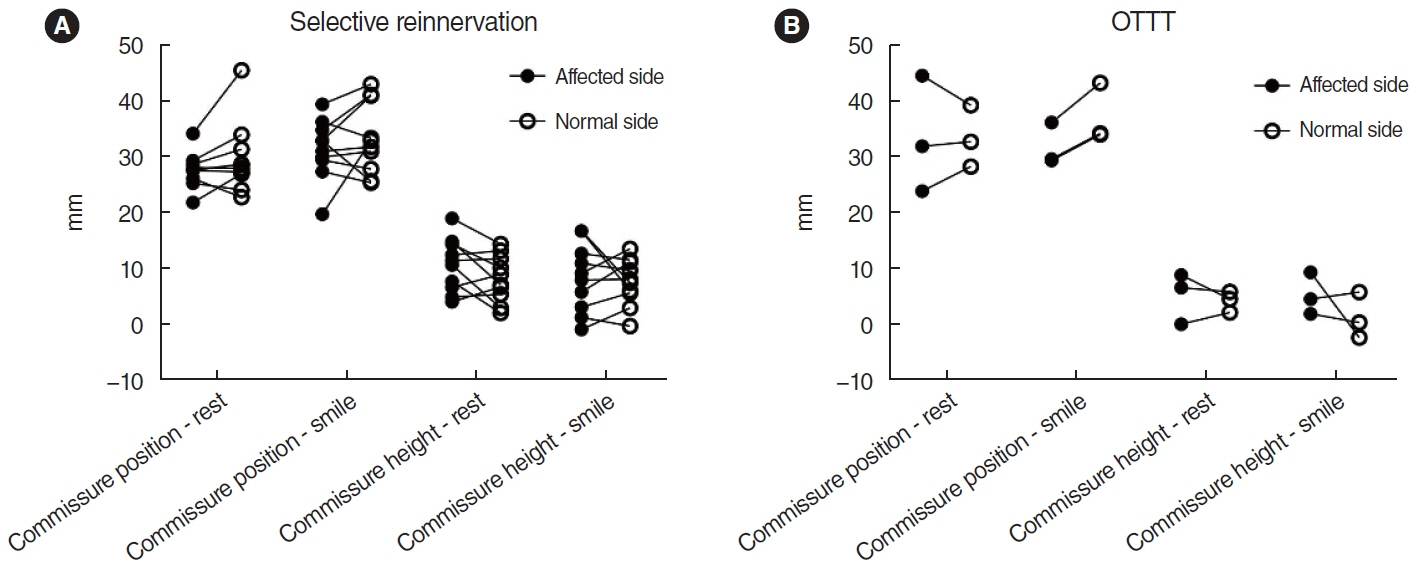Clin Exp Otorhinolaryngol.
2024 Aug;17(3):263-271. 10.21053/ceo.2024.00094.
Functional Outcomes of Single-Stage Facial Reanimation Surgery With Radical Parotidectomy
- Affiliations
-
- 1Department of Otorhinolaryngology-Head and Neck Surgery, Seoul National University Bundang Hospital, Seongnam, Korea
- 2Department of Otorhinolaryngology-Head and Neck Surgery, Seoul National University College of Medicine, Seoul, Korea
- 3Department of Otorhinolaryngology-Head and Neck Surgery, National Medical Center, Seoul, Korea
- 4Department of Otorhinolaryngology-Head and Neck Surgery, Seoul National University Hospital, Seoul, Korea
- KMID: 2558843
- DOI: http://doi.org/10.21053/ceo.2024.00094
Abstract
Objectives
. Facial nerve sacrifice during radical parotidectomy can impair quality of life. This study assessed the effectiveness of single-stage facial reanimation surgery performed concurrently with radical parotidectomy in restoring facial function.
Methods
. A retrospective analysis was conducted on patients who underwent single-stage facial reanimation combined with radical parotidectomy. The techniques employed included selective reinnervation and orthodromic temporalis tendon transfer. Outcomes were evaluated using the modified House-Brackmann and Terzis grading systems, Emotrics facial assessment, and the Facial Disability Index (FDI).
Results
. Among the 13 patients studied (median age, 54 years; 69% male), 10 underwent selective reinnervation. Of these, nine patients demonstrated improvement, achieving House-Brackmann grade III and Terzis grade 4 or 5. The other three patients underwent tendon transfer and achieved moderate functional outcomes. Emotrics analysis revealed balanced facial symmetry in the selective reinnervation group. Furthermore, FDI scores indicated satisfactory physical and social/well-being functions.
Conclusion
. Single-stage facial reanimation effectively restores facial function in patients undergoing radical parotidectomy. This approach offers meaningful benefits in the early recovery of facial function.
Figure
Reference
-
1. Spiro RH, Huvos AG, Strong EW. Cancer of the parotid gland: a clinicopathologic study of 288 primary cases. Am J Surg. 1975; Oct. 130(4):452–9.2. Pedersen D, Overgaard J, Sogaard H, Elbrond O, Overgaard M. Malignant parotid tumors in 110 consecutive patients: treatment results and prognosis. Laryngoscope. 1992; Sep. 102(9):1064–9.3. Gunn A, Parrott NR. Parotid tumours: a review of parotid tumour surgery in the Northern Regional Health Authority of the United Kingdom 1978-1982. Br J Surg. 1988; Nov. 75(11):1144–6.4. Guntinas-Lichius O, Gabriel B, Klussmann JP. Risk of facial palsy and severe Frey’s syndrome after conservative parotidectomy for benign disease: analysis of 610 operations. Acta Otolaryngol. 2006; Oct. 126(10):1104–9.5. Swendseid B, Li S, Thuener J, Rezaee R, Lavertu P, Fowler N, et al. Incidence of facial nerve sacrifice in parotidectomy for primary and metastatic malignancies. Oral Oncol. 2017; Oct. 73:43–7.6. Shindo M. Management of facial nerve paralysis. Otolaryngol Clin North Am. 1999; Oct. 32(5):945–64.7. Hotton M, Huggons E, Hamlet C, Shore D, Johnson D, Norris JH, et al. The psychosocial impact of facial palsy: a systematic review. Br J Health Psychol. 2020; Sep. 25(3):695–727.8. Hodgkinson DJ, Woods JE. The influence of facial-nerve sacrifice in surgery of malignant parotid tumors. J Surg Oncol. 1976; 8(5):425–32.9. Lu GN, Villwock MR, Humphrey CD, Kriet JD, Bur AM. Analysis of facial reanimation procedures performed concurrently with total parotidectomy and facial nerve sacrifice. JAMA Facial Plast Surg. 2019; Jan. 21(1):50–5.10. Sahovaler A, Yeh D, Yoo J. Primary facial reanimation in head and neck cancer. Oral Oncol. 2017; Nov. 74:171–80.11. Henstrom DK, Skilbeck CJ, Weinberg J, Knox C, Cheney ML, Hadlock TA. Good correlation between original and modified House Brackmann facial grading systems. Laryngoscope. 2011; Jan. 121(1):47–50.12. Terzis JK, Noah ME. Analysis of 100 cases of free-muscle transplantation for facial paralysis. Plast Reconstr Surg. 1997; Jun. 99(7):1905–21.13. Guarin DL, Dusseldorp J, Hadlock TA, Jowett N. A machine learning approach for automated facial measurements in facial palsy. JAMA Facial Plast Surg. 2018; Jul. 20(4):335–7.14. VanSwearingen JM, Brach JS. The Facial Disability Index: reliability and validity of a disability assessment instrument for disorders of the facial neuromuscular system. Phys Ther. 1996; Dec. 76(12):1288–300.15. Gao Z, Jia XH, Xu J, Yu J, Wang J, Zhao WD, et al. Neurorrhaphy for facial reanimation with interpositional graft: outcome in 23 patients and the impact of timing on the outcome. World Neurosurg. 2019; Jun. 126:e688–93.16. Socolovsky M, Martins RS, di Masi G, Bonilla G, Siqueira M. Treatment of complete facial palsy in adults: comparative study between direct hemihypoglossal-facial neurorrhaphy, hemihipoglossal-facial neurorrhaphy with grafts, and masseter to facial nerve transfer. Acta Neurochir (Wien). 2016; May. 158(5):945–57.17. Wang WJ, Zhu WD, Tremp M, Chen G, Wang ZY, Wu H, et al. Facial reanimation with interposition nerve graft or masseter nerve transfer: a comparative retrospective study. Neural Regen Res. 2022; May. 17(5):1125–30.18. Gyori E, Przestrzelski C, Pona I, Hagmann M, Rath T, Radtke C, et al. Quality of life and functional assessment of facial palsy patients: a questionnaire study. Int J Surg. 2018; Jul. 55:92–7.19. Marsk E, Hammarstedt-Nordenvall L, Engstrom M, Jonsson L, Hultcrantz M. Validation of a Swedish version of the Facial Disability Index (FDI) and the Facial Clinimetric Evaluation (FaCE) scale. Acta Otolaryngol. 2013; Jun. 133(6):662–9.
- Full Text Links
- Actions
-
Cited
- CITED
-
- Close
- Share
- Similar articles
-
- Masseter nerve-based facial palsy reconstruction
- An Algorithm to Guide Recipient Vessel Selection in Cases of Free Functional Muscle Transfer for Facial Reanimation
- Facial reanimation using the hypoglossal nerve and ansa cervicalis: a short-term retrospective analysis of surgical outcomes
- Selective Deep Lobe Parotidectomy for Preservation of Parotid Function: A Case Report
- Functional Outcomes of Multiple Sural Nerve Grafts for Facial Nerve Defects after Tumor-Ablative Surgery




